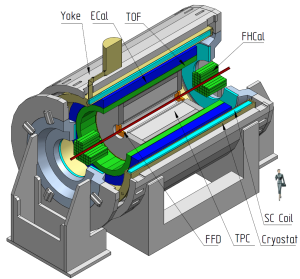
The Multi-Purpose Detector (MPD) is one of the two dedicated heavy-ion collision experiments of the Nuclotron-based Ion Collider fAcility (NICA), one of the flagship projects at the Joint Institute for Nuclear Research (JINR). Its main scientific purpose is to search for novel phenomena in the baryon-rich region of the QCD phase diagram by means of colliding heavy nuclei in the energy range of 4 GeV<√sNN<11GeV. A wealth of results, obtained by colliding heavy ions at different beam energies, has been gathered by experiments at SIS, AGS, SPS, RHIC and the LHC facilities. The new experimental program at the NICA-MPD will fill a niche in the energy scale, which is not yet fully explored, and the results will bring about a deeper insight into hadron dynamics and multiparticle production in the high baryon density domain.
It is foreseen that the MPD will be installed in two stages. The first stage of the detector configuration is planned to be ready for commissioning in 2025. The overall set-up of the MPD and the spatial arrangement of detector subsystems in the first stage are shown in the figure.

The “central barrel” components have an approximate cylindrical symmetry within |η|<1.5. The beam line is surrounded by the large volume Time Projection Chamber (TPC) which is enclosed by the TOF barrel. The TPC is the main tracker, and in conjunction with the TOF they will provide precise momentum measurements and particle identification. The Electromagnetic Calorimeter (ECal) is placed in between the TOF and the MPD magnet. It will be used for detection of electromagnetic showers, and will play the central role in photon and electron measurements. The MPD superconducting solenoid magnet is designed to provide a highly homogeneous magnetic field of up to 0.57 T (with a default operational setting of 0.5 T), uniform along the beam direction, to ensure appropriate transverse momentum resolution for reconstructed particles within the range of momenta of 0.1-3 GeV/c. As the average transverse momentum of the particles produced in a collision at NICA energies is below 500 MeV/c, the detector was designed to have a very low material budget. In the forward direction, the Fast Forward Detector (FFD) is located still within the TPC barrel. It will play the role of a wake-up trigger. The Forward Hadronic Calorimeter (FHCal) is located near the magnet end-caps. It will serve for determination of the collision centrality and the orientation of the reaction plane for collective flow studies.
Additional detectors are proposed in the later stages. The silicon-based Inner Tracking System (ITS) will be installed close to the interaction point in the second stage of the MPD construction. It will greatly enhance tracking and secondary vertex reconstruction capabilities. The miniBeBe detector, placed between the beam pipe and the TPC, close to the beam, is designed to aid in triggering and start time determination for the TOF. Installation of forward spectrometers is discussed to extend detector coverage up to η~3.
